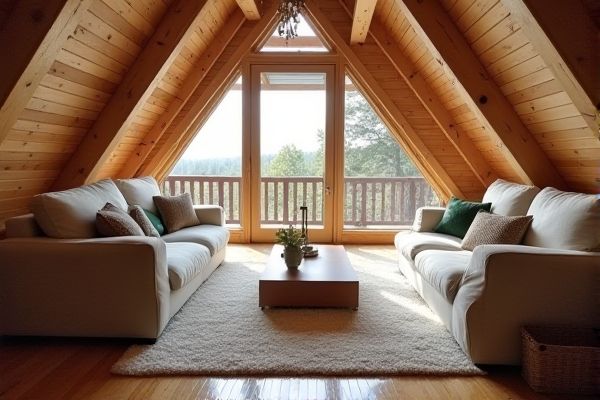
Attic storage maximizes unused space for organized belongings, while attic living space transforms the area into functional rooms that enhance your home's comfort and value. Discover how to choose the best option for your needs in the rest of the article.
Table of Comparison
| Feature | Attic Storage | Attic Living Space |
|---|---|---|
| Purpose | Storage of items, seasonal goods, and boxes | Habitable area for bedrooms, offices, or lounges |
| Insulation | Minimal to none | Full insulation for temperature control |
| Flooring | Basic, often unfinished or plywood | Finished flooring suitable for daily use |
| Lighting & Ventilation | Limited natural light; basic ventilation | Windows, proper ventilation, and natural light |
| Building Codes | Few or no code requirements | Must comply with residential building codes |
| Access | Pull-down ladder or stairs | Permanent staircase with safe egress |
| Cost | Low to moderate investment | High investment due to finishing and permits |
| Value Added | Increases storage capacity | Increases living area and home value |
Introduction to Attic Spaces: Storage vs. Living
Attic storage typically involves using the space for organized, accessible storage of seasonal items, boxes, and seldom-used belongings, optimizing vertical space with shelving or bins. Attic living spaces require proper insulation, ventilation, and structural reinforcements to convert the area into habitable rooms like bedrooms, offices, or playrooms. Differentiating between these uses is essential for compliance with building codes, safety standards, and maximizing the functional value of the attic.
Benefits of Using an Attic for Storage
Attic storage maximizes unused space, providing a cost-effective solution to declutter living areas and safely store seasonal items, keepsakes, and rarely used belongings. Properly insulated and ventilated attics protect stored items from moisture and temperature fluctuations, extending their lifespan. Utilizing attic storage increases overall home organization without the need for expensive expansions or renovations.
Advantages of Converting an Attic to Living Space
Converting an attic to living space maximizes usable square footage without the need for home expansion, significantly increasing property value and appeal. Enhanced insulation and ventilation during the conversion improve energy efficiency and comfort, reducing utility costs. Additionally, creating a custom-designed living area adds versatility for bedrooms, offices, or recreational rooms, optimizing underutilized space.
Key Differences: Storage Attic vs. Living Attic
Storage attics are primarily designed to hold seasonal items, boxes, and less frequently used belongings, typically featuring unfinished floors, limited insulation, and minimal lighting. Living attics require proper insulation, ventilation, finished flooring, and compliance with building codes to ensure comfort and safety as habitable spaces. Your decision between these options depends on whether you prioritize maximizing storage capacity or creating functional, livable rooms.
Cost Considerations for Attic Renovations
Attic storage conversions typically cost less than attic living space renovations due to fewer requirements for insulation, ventilation, and building code compliance. Converting your attic into a living area involves expenses for electrical wiring, plumbing, heating, cooling, and finishing materials, which can significantly increase the budget. Understanding these cost differences is essential for planning your attic renovation within an affordable range.
Insulation and Ventilation Requirements
Attic storage requires basic insulation and ventilation to prevent moisture buildup and temperature extremes that can damage stored items. Attic living space demands higher insulation R-values and continuous ventilation to maintain comfortable indoor temperatures and prevent mold growth. Ensuring proper insulation and ventilation in your attic supports both energy efficiency and structural integrity depending on the intended use.
Safety and Building Code Compliance
Attic storage areas must meet specific safety standards such as proper ventilation, load-bearing capacity, and fire-resistant materials to comply with building codes and prevent hazards. Converting an attic into living space requires adherence to stricter regulations, including minimum ceiling height, emergency egress windows, insulation, and electrical safety to ensure occupant safety and comfort. Both uses necessitate professional inspection and permits to align with local building codes and avoid structural or legal issues.
Design Ideas for Attic Living Spaces
Maximizing attic living space requires innovative design ideas that balance functionality and comfort, such as built-in storage solutions, skylights for natural lighting, and custom insulation for energy efficiency. Incorporating multi-purpose furniture and utilizing vertical space can transform an attic into a cozy bedroom, home office, or studio while maintaining clutter-free aesthetics. Strategic use of drywall, hardwood flooring, and neutral color palettes enhances spatial perception, making attic living areas inviting and practical.
Maximizing Attic Storage Efficiency
Maximizing attic storage efficiency involves utilizing custom shelving, modular storage units, and clear labeling to keep your items organized and accessible. Insulating and ventilating the attic properly prevents damage to stored belongings, while maintaining maximum floor space by using vertical storage solutions optimizes available capacity. You can transform your attic into a highly functional area without converting it into full living space.
Choosing the Best Option: Storage or Living Space
Choosing between attic storage and attic living space depends on your home's square footage and lifestyle needs. Attic living space enhances functionality and property value by providing extra bedrooms or a home office, while attic storage maximizes unused space for seasonal items or rarely used belongings. Evaluate your priorities and budget to determine if investing in insulation, flooring, and ventilation for living space outweighs the simplicity and cost-effectiveness of storage solutions.
 homyna.com
homyna.com